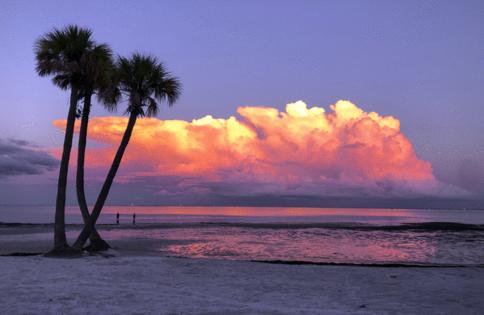Saharan dust is heading toward Florida and can change weather. What about hurricanes?
Published in Weather News
MIAMI — Plumes of Saharan dust are heading to Florida and may be seen by the weekend, according to forecasters.
But will the dust affect the weather?
In the short term, the rain in the forecast the next several days won’t be tempered by the dust, said Ana Torres-Vasquez, a meteorologist with the National Weather Service in Miami.
But the presence of Saharan dust, starting on Saturday May 31 and lasting for a few days, could mute tropical systems in the Atlantic.
Here’s what to know about Saharan dust, the weather and your health:
What is Saharan dust and how does it affect weather?
The arrival of Saharan dust is usually good news for the tropics, but bad for allergies and respiratory issues. And it ramps up the heat in an already sweltering stretch.
Saharan dust, also referred to as the Saharan Air Layer by the National Oceanic and Atmospheric Administration, is “a mass of very dry, dusty air that forms over the Sahara Desert during the late spring, summer, and early fall.” A dust cloud whipped up from Africa’s Sahara Desert — a 3.6-million-square-mile hot desert, the largest in the world — moves over the tropical North Atlantic Ocean every three to five days, according to NOAA.
The Saharan dust layer is typically 2 to 2.5 miles thick and about a mile above the earth’s surface. Saharan dust doesn’t have a named season, like the wet season or hurricane season or lovebug season, but its activity has prevalent periods.
The activity usually ramps up in mid-June, peaks from late June to mid-August, and begins to rapidly subside after mid-August, NOAA explains. During peak periods, these outbreaks emerge from the coast of Africa every three to five days and can travel more than 5,000 miles to the west carried by trade winds to places including Florida, the Caribbean, Texas, Kansas and Central America and cover vast areas of the Atlantic Ocean.
The arriving dust in Florida this weekend, and lingering for a few days, isn’t unusual. Lots of dust is blown from Africa each year and Florida always get some of the plumes.
Can Saharan dust keep the hurricanes away?
Saharan dust suppresses tropical cyclone formation and intensification, according to the National Weather Service and NOAA. That’s great news for the forecast of a busy hurricane season, which begins June 1 and stretches through Nov. 30.
Why does Saharan dist suppress storms?
—Saharan dust is an extremely dry, dusty air mass, containing about 50% less moisture than the typical tropical atmosphere, the National Hurricane Center notes. “This extremely dry air can weaken a tropical cyclone or tropical disturbance by promoting downdrafts around the storm.”
—Strong winds in the Saharan dust layer of about 25-55 mph, referred to as an “African easterly jet” by forecasters, substantially increase the vertical wind shear in and around the storm environment. This “jet” of big winds at a height of 6,500 to 14,500 feet can cause a tilting of the tropical cyclone vortex and can disrupt the storm’s internal heat engine, according to the weather service. Think of it like the proverbial monkey wrench left in your car’s engine by a careless mechanic. The “engine” is going to react negatively eventually.
—The warm temperatures in the Saharan dust layer riding above relatively cooler, denser air, stabilizes the atmosphere, which can suppress the formation of clouds, meteorologists say.
Can Saharan dust affect your breathing?
Saharan dust can irritate eyes, ears, nose and throat. If you have allergies or respiratory health issues like asthma or chronic bronchitis, you may want to stay indoors and take your allergy medication.
Can you see the Saharan dust?
Usually, you can notice the haze. But between the upcoming rain, you may also notice more vibrant sunsets.
The reason has to do with how light from the sun makes its way to Earth and how its wavelengths interact with the dust cloud. The filtering of shorter wavelengths of blue, green and purple during sunset and the longer wavelengths of orange, pink and red that amplify at sunset get enhanced by the dust in the upper atmosphere, meteorologists explain.
This amplification, like a filter on your camera, enhances the colors of the sunset to make them appear deeper and richer after the wavelengths’ interaction with the dust particles. And with all that come more vibrant sunsets in Florida.
©2025 Miami Herald. Visit at miamiherald.com. Distributed by Tribune Content Agency, LLC.







Comments